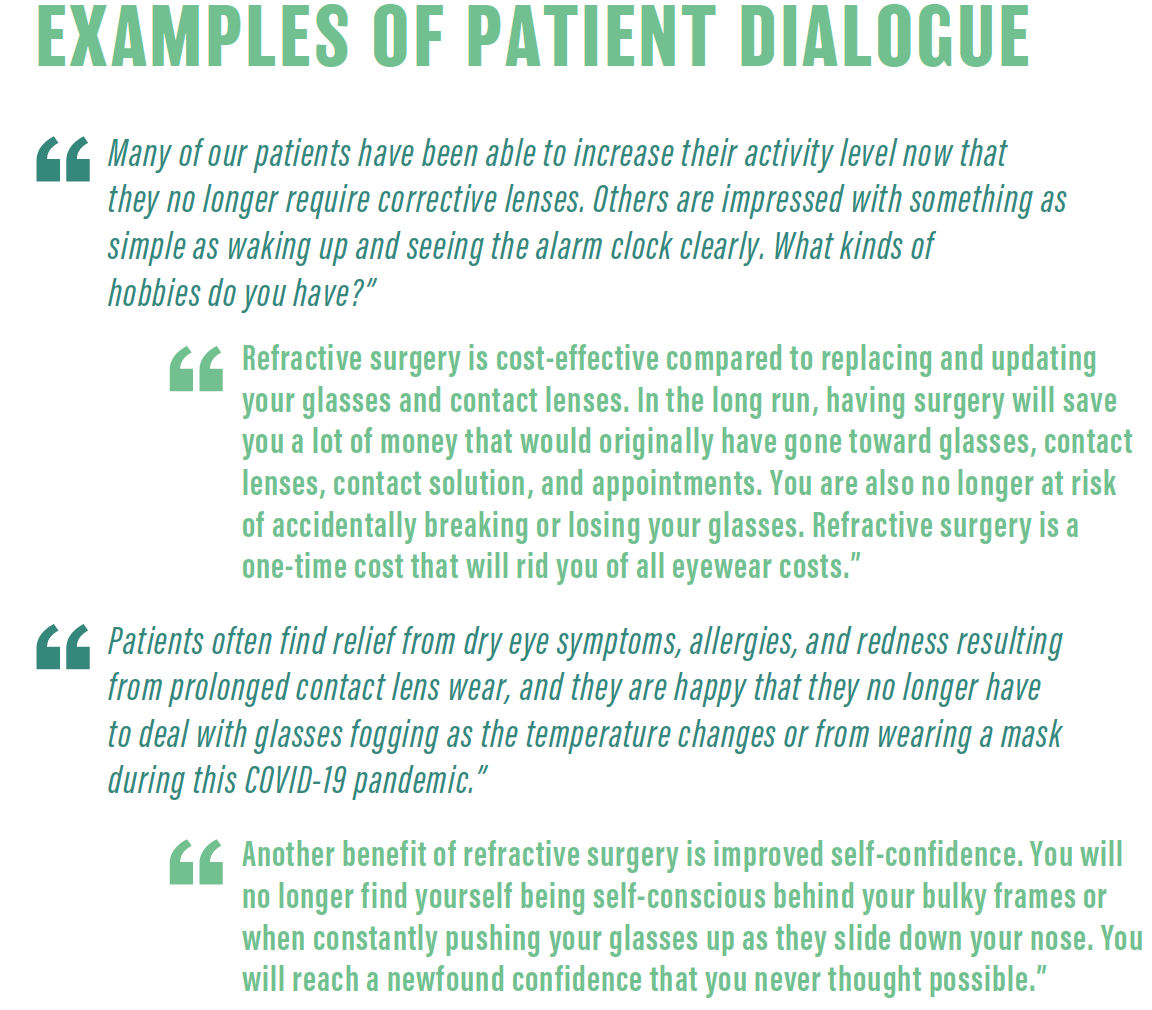The Paradox of Choice
Arthur B. Cummings, MB ChB, FCS(SA), MMed(Ophth), FRCS(Edin)

The psychologist Barry Schwartz delivered a popular TED Talk with this same title—The Paradox of Choice. He explained that, when people have too many choices, they end up making no choices. Yes, you read that correctly. When the options are overwhelming, the easiest way out is simply to maintain the status quo…and do nothing.
How does this sentiment relate to vision correction surgery?
A patient seeking better vision—seeking an improvement in quality of vision and therefore quality of life—is interested not in the specific procedure but rather in the promise of a changed life, one free of glasses and contact lenses. If all vision correction surgeries were called just that, we surgeons would be significantly busier than we already are. Because vision correction surgeries are instead called things like LASIK, PRK, SMILE, phakic IOL implantation, and refractive lens exchange, each of which can itself involve myriad choices, patients often feel overwhelmed by the options and frightened that they may select the wrong procedure for themselves. The paradox of choice may then kick in.
Providers and manufacturers can exacerbate this problem by claiming that one procedure or offering is better or safer than another. This behavior is the reason that the market is flat and the reason that overall surgical volume is going down. In the short term, clever marketing may protect a practice, but it does so at the expense of the entire market. This strategy is not sustainable in the long term. Imagine if car manufacturers followed this model. Instead of highlighting the experience of driving their cars, they would claim that another company’s cars were less safe and more poorly built.
Our patients want to see better, and they trust us to guide them. They desire clarity and confidence, not confusion and uncertainty. If we or our websites disparage another procedure, a cycle of mistrust is initiated.
Professionalism is a better way. We examine the patient, consider all of the appropriate options, and recommend the best one for them—without bashing another procedure.
CONCLUSION
We live in an era when vision correction surgery offers outstanding outcomes and exceptional safety. These life-changing procedures represent an enormous value proposition that should make them the first choice for eligible candidates, ahead of spectacles and contact lenses. We are doctors who want what is in the best interest of our patients, and we want more patients to enjoy the benefits that vision correction surgery can offer. The pathway to that outcome, for all of our sakes, is to promote not only the procedure or procedures that we happen to offer but the entire category of vision correction surgery.
Maintain Trust by Choosing What Is Best for the Patient
Sheraz M. Daya, MD, FACP, FACS, FRCS(ED), FRCOphth;

I was asked to write a short piece on how to avoid pushing one refractive surgery technology over another. The request made me reflect a little on how I actually do practice.
Starting with the fundamentals, patients come to see us in trust. Most of the time, they are seeking the best care they can get—when it comes to vision correction, this means the best range of vision with minimal risk, a high level of reliability, and a minimum of adverse effects. Finally, they all want to be sure this will last for the long haul. Patients want it all, and why not?
As a providing surgeon, therefore, I choose what I believe is really best for that patient. This may range from performing laser vision correction in one eye to implanting trifocal IOLs in both eyes, depending on the patient’s specific situation. In other words, I customize the options to suit the individual.
Do I give patients a choice? Usually not, or, if there is a possible option (eg, LASIK vs phakic IOL), I provide them with the pros and cons of each and undoubtedly influence them in the direction that I believe suits them best. Yes, patients will sign the consent form indicating that the risks, benefits, and alternatives have been explained and that they have made a choice. However, this is truly a shared decision between me and the patient, based on shared trust.
In terms of meeting expectations and considering risk, there are differing solutions for different age groups. Additionally, patients’ occupations, sports, and hobbies will influence the choice of procedure. The specific optical requirements will also influence the decision, as will the health of the eye. Getting even more specific, the corneal optics (level of aberrations, astigmatism, and shape) as well as anterior chamber depth and overall axial length will affect the choice, for instance of IOL and lens power. The latter influences my decision process, and, while I might allude to this in my discussion with patients, it can be a little too much information couched with far too much jargon for them to understand (unless of course the patient is a refractive surgeon—who will usually vote with their feet anyway).
In summary, I do not pitch one refractive technology or procedure over another. My goal is to have happy patients and to exceed their expectations. So it is best to choose the correct procedure for them (not influenced by revenue) and manage their expectations. To conclude, I always keep in mind a pearl I learned as a fellow under Richard L. Lindstrom, MD, back in 1991: Patient Satisfaction = Outcome – Expectation. And satisfied patients really do drive the practice.
Accentuate the Positive!
Erik L. Mertens, MD, FEBOphth

Refractive surgery took a giant leap forward in the 1990s with the introduction of the excimer laser to correct refractive errors.1 At that time, each laser manufacturer promoted its specific brand and focused on the device’s eye tracker efficiency and laser repetition rate, as if these were the most important factors to achieve the best postoperative results. More recently, with the introduction of presbyopia-correcting IOLs, the industry marketing machine once again promoted different names, brands, and types of IOLs—bifocal, multifocal, trifocal, extended depth of focus, hybrid—the growing list can confuse even eye surgeons.2
FOCUS ON BENEFITS
In both of these circumstances, our patients are not interested in and/or excited by these types of technology messaging. Instead of referencing these marketing points with our patients, refractive surgeons should focus on and market patient benefits. Ultimately, this strategy will drive growth in refractive surgery. Our messaging to patients should be directed toward how their choice will affect their lifestyle. Some examples of the typical dialogue I share with patients are presented in the accompanying sidebar.

It is also important to avoid marketing one’s promotional pricing and discounts. Advertising a discounted price for a limited time can create the impression of diminished quality or, even worse, suggest that patients routinely pay too much for our services. Have you ever seen plastic surgeons discount their prices?
CONCLUSION
It should become the new normal to evaluate patients’ eye conditions and expectations thoroughly before discussing surgical options, whether laser- or lens-based. Just imagine that every patient is a family member sitting in front of you. What procedure would you propose to achieve excellent refractive results and satisfaction for your sister or your father? Everyone—your practice, your patients, and your refractive surgery colleagues—will benefit if we can all make the pond bigger.
1. Trokel SL, Srinivasan R, Braren B. Excimer laser surgery of the cornea. Am J Ophthalmol. 1983;96(6):710-715.
2. Ang M, Gatinel D, Reinstein D, Mertens E, Alio Del Barrio J, Alio J. Refractive surgery beyond 2020 [published online ahead of print 2020 Jul 24]. Eye. 2020;10.1038/s41433-020-1096-5.




